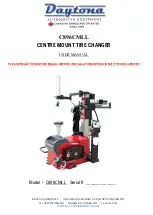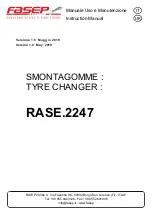
ENGLISH • Instructions manual
37
S 45 TL
S 45 TL
CAUTION: If the tyre is equipped with a pressure sensor, begin mounting with the valve in the 7 o’clock position relative to head.
7)
Rotate the turntable clockwise by pressing the pedal (
1, Fig. D
) and keep the tyre bead pressed into the inner seat on the wheel rim with
the hands.
8)
In the case of tyres with an inner tube, insert the inner tube now.
MOUNTING THE SECOND BEAD
9)
Move the valve into approximately the 5 o’clock position.
10)
Repeat the steps from 6 onwards for the upper tyre bead, pressing the tyre
at approximately the 3 o’clock position to push the bead into the wheel rim
well (
see Fig. H2
). Start turntable rotation and keep the sidewall of the tyre
depressed as the tyre rotates until the bead is fully mounted.
11)
When the bead is fully mounted, press the pedal (
7, Fig. D
) to move the
arm (
11, Fig. D
) away from the work position.
12)
Press the pedal (
5, Fig. D
) to release the wheel from the turntable.
N.B.: The turntable is rotated clockwise for both demounting and mounting. The anticlockwise function is used only to rectify any
operator errors.
SPECIAL WHEELS
When equipped with special optional accessories, the S 45 TL is able to work on special wheels: PAX SYSTEM (with PT+KPX), SR
Support Ring (with PT+KSR) and Run Flat, low profile and UHP (with PT).
The correct working procedures for these wheels are described in the instruction manuals provided with the specific accessories.
10.5 BEAD SEATING AND INFLATING
DANGER!!
Tyre inflation is dangerous.
Follow carefully all the cautions and instructions given.
DANGER!!
Tyre or rim failure under pressure is hazardous and any resulting explosion can propel the
tyre upward and outward with sufficient energy to cause serious injury or death to operator or
bystander.
Though this tyre changer is equipped with a pressure limiter set at 3.5 bar (50 Psi), it is not
intended to be a safety device to contain exploding tyres, tubes, rims or bead sealing
equipment and, hence, does not eliminate the risk of and damage from any such explosion.
A WHEEL CAN EXPLODE IF:
1) the diameter of the rim is not exactly the same at the tyre’s.
2) the rim or tyre are defective.
3) if the maximum recommended pressure is exceeded during bead seating.
4) the tyre is inflated to a pressure higher than the maximum recommended by the manufacturer.
5) the operator does not observe the requisite safety regulations.
H2



































